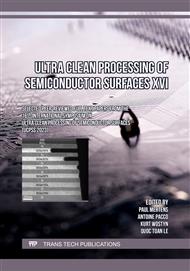[1]
T. Tanaka, M. Morigami, and N. Atoda, Jpn. J. Appl. Phys., 32(12S), 6059 (1993).
Google Scholar
[2]
S. F. Chini and A. Amirfazli, Langmuir, 26(16), 13707 (2010).
Google Scholar
[3]
M. Kotera and N. Ochiai, Microelectronic Engineering, 78-79, 515 (2005).
Google Scholar
[4]
I. Vos, D. Hellin, J. Vertommen, M. Demand, and W. Boullart, ECS Trans., 41(5), 189 (2011).[5] N. Vrancken, G. Vereecke, S. Bal, S. Sergeant, G. Doumen, F. Holsteyns, H. Terryn, S. de Gendt, and X. M. Xu, Solid State Phenomena, 255, 136 (2016).
DOI: 10.4028/www.scientific.net/ssp.255.136
Google Scholar
[6]
N. Vrancken, T. Ghosh, U. Anand, Z. Aabdin, S. W. Chee, Z. Baraissov, H. Terryn, S. D. Gendt, Z. Tao, X. Xu, F. Holsteyns, and U. Mirsaidov, J. Phys. Chem. Lett., 11(7), 2751 (2020).
DOI: 10.1021/acs.jpclett.0c00218
Google Scholar
[7]
A. Mallavarapu, P. Ajay, and S. V. Sreenivasan, Nano Lett., 20(11), 7896 (2020).
Google Scholar
[8]
H. Liu and G. Cao, Scientific Reports, 6, 23936 (2016).
Google Scholar
[9]
T. Namazu, Y. Isono, and T. Tanaka, Journal of Microelectromechanical Systems, 9(4), 450 (2000).
Google Scholar
[10]
Q. Jin, T. Li, P. Zhou, and Y. Wang, J. Nanomaterials, 2009, 6:1 (2009).
Google Scholar
[11]
B. Lee and R. E. Rudd, Phys. Rev. B, 75(4), 041305 (2007).
Google Scholar
[12]
X. M. Xu, N. Vrancken, G. Vereecke, S. Suhard, G. Pourtois, and F. Holsteyns, Solid State Phenomena, 255, 147 (2016).
DOI: 10.4028/www.scientific.net/ssp.255.147
Google Scholar
[13]
Q. Yuan and Y.-P. Zhao, Sci Rep, 3(1), 1944 (2013).
Google Scholar
[14]
D. Bassett and A. Rotondaro, ECS Trans., 80(2), 29 (2017).
Google Scholar
[15]
A. P. Thompson, H. M. Aktulga, R. Berger, D. S. Bolintineanu, W. M. Brown, P. S. Crozier, P. J. in 't Veld, A. Kohlmeyer, S. G. Moore, T. D. Nguyen, R. Shan, M. J. Stevens, J. Tranchida, C. Trott, and S. J. Plimpton, Computer Physics Communications, 271, 108171 (2022).
DOI: 10.1016/j.cpc.2021.108171
Google Scholar
[16]
F. H. Stillinger and T. A. Weber, Phys. Rev. B, 31(8), 5262 (1985).
Google Scholar
[17]
W. Damm, A. Frontera, J. Tirado-Rives, and W. L. Jorgensen, Journal of Computational Chemistry, 18(16), 1955 (1997).
Google Scholar
[18]
H. Sun, L. Chen, S. Sun, and T.-Y. Zhang, Sci. China Technol. Sci., 61(5), 687 (2018).
Google Scholar


